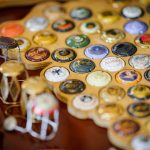The bottle cap collector
Beppi Piovesan: from celebrated sommelier to renowned collector, with a special passion for Conegliano Valdobbiadene DOCG

By Marina Grasso
“We bottle cap collectors are a bit like grownups playing with trading cards, but the caps we collect offer unusual and exciting insights into many aspects of sparkling winemaking.” This is how Giuseppe Piovesan describes the boxes of caps he’s brought to Villa dei Cedri in Solighetto, headquarters of the Conegliano Valdobbiadene Prosecco Superiore DOCG Protection Consortium. He’s there to display his outstanding collection of bottle caps, which, for the uninitiated, are the metal disks placed on the top of sparkling wine corks and held in place by the safety cage.
Known to all as Beppi, Piovesan is very well-known in the Conegliano Valdobbiadene area. In addition to owning one of the largest collections of bottle caps in Italy (“certainly among the top fifty,” he says), he’s also been a professional sommelier for over 40 years and a cornerstone of the Italian Association of Sommeliers (AIS). His is a face familiar to fans of Conegliano Valdobbiadene thanks to his invaluable assistance at many local events.
It is as a passionate connoisseur of wine culture first, and as a proud collector second, that he tells us the history of these small objects while showing us the caps he has neatly arranged in dozens of trays, display cases, albums and catalogues, along with the distinctive features of many historic bottles and other curiosities he’s amassed throughout his career: “It was back in 1844 that Adolphe Jacquesson, a Champagne producer from Chalon-sur-Marne, patented his system for securing sparkling wine bottle corks. It comprised a cage enclosing a metal cap at the top, and his method for corking sparkling wines is still the one we use to this day.” It was an ingenious invention that has remained virtually unchanged, though the shape has undergone numerous changes. Beppi continues: “At first the caps were just anonymous, functional galvanised metal discs. Then in the early 20th century French winemakers began to personalise them. When metal printing techniques improved, around 1940, the first lithographed and silk-screened caps appeared. These became increasingly decorative and attractive, so people started collecting them.”
Needless to say, cap collecting first took off in the Champagne region, before gradually gaining popularity in Spain and Italy and finally expanding overseas following the development of localised production of sparkling wines. “In the early 80s cap collecting was quite rare and often only caps were collected from bottles opened for a special occasion”, continues Bepi, who met the then newly formed Cap Collectors Club during an event in Valdobbiadene back in 2000. “As a wine enthusiast, I’d already begun collecting a few special bottles and the odd distinctive cap some time before. But learning about the world of collecting sparked my curiosity and I began to save the caps. Thanks to my hobby and my many friends in the industry who generously helped me to source interesting caps, in just a short time my collection began to take shape, and so started this exciting adventure.”
Today, Beppi has amassed a collection of some 30,000 caps. “About 8,000 of my caps are Italian, plus around 16,000 French and 3,000 Spanish ones, along with many more from numerous other countries. I also have some very unusual ones, such as some made of bronze from Argentina which weigh up to 15-20 grams as opposed to the usual 3 grams of the modern ones. I also have many rare, numbered and commemorative caps, as well as some crafted from hand-turned oak which are exquisite sculptures in miniature. Nowadays, personalised caps are a small feature that has taken on a huge significance for winemakers as they try to make them increasingly valuable and sophisticated – not only for collectors, but also as a symbol of the great care that goes into the crafting of their wines. For instance, one of the most distinctive caps I remember is from some limited-edition bottles with caps set with a Swarovski crystal, made by a winemaker from Conegliano Valdobbiadene.”
In addition to caps, Bebbi is an enthusiastic collector of other items too: “I also collect unusual, commemorative and historic bottles, along with commemorative glass holder bags used at wine events, stamps with clusters of grapes or bottles of wine on them, all items that have attracted the attention of specialist collectors within the wine sector. And I’ve collected over 50 books on the subject of Prosecco Superiore.” His collection expresses the strong bond he has with the Conegliano Valdobbiadene region and also includes priceless items that represent real milestones in the development of local winemaking: “One of my most treasured bottles is a Prosecco DOC 1969. It was made by the Valdobbiadene cooperative winery to mark the year when the Denomination was awarded official recognition. Another favourite of mine is a Carpenè Malvolti from 1934. It boasts a cap made from a mixture of steel and iron and was made for the Royal House of Savoy.” He shows us this with the same pride he demonstrates for another of his gems – a 1984 Sassicaia.
[Article originally published in Visit Conegliano Valdobbiadene magazine Fall Winter 2023. The entire magazine is available here]



